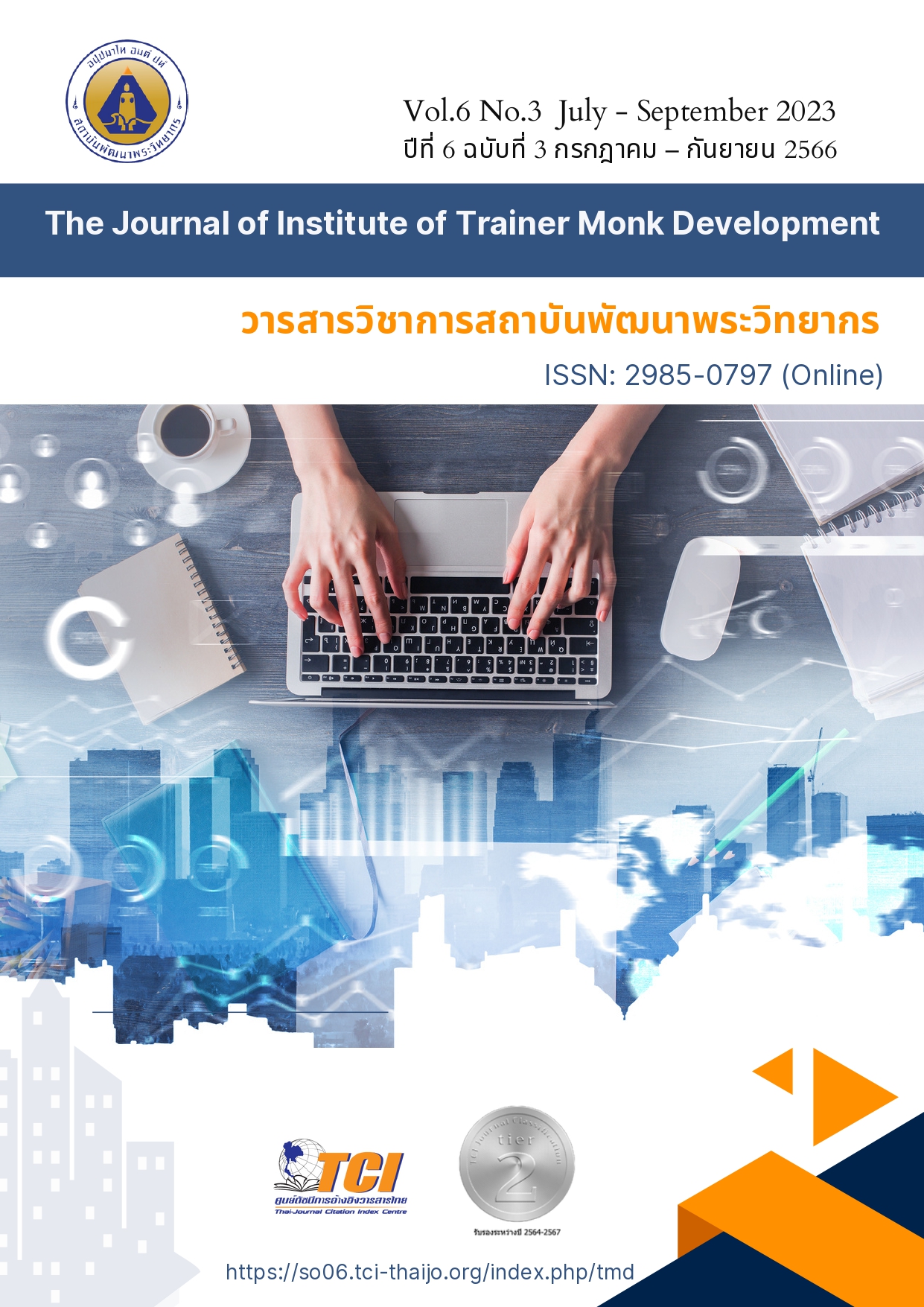Chanting Resulting in the Quality of Life Development of Buddhists in Samut Sakhon Province
Main Article Content
Abstract
The objectives of this research article are 1) to study the meaning, importance and value of chanting in Buddhism, 2) to study the virtue of chanting that affects quality of life development, and 3) to present effective chanting to improve the quality of life of Buddhists in Samut Sakhon Province. The researcher conducted according to the integrated research methodology. It consists of quantitative research using a survey research method. The sample group used in this research is the population used in the research, namely "Wat Pom Wichien Chotikaram Temple Evening Prayer Club" and 121 people in Samut Sakhon province by opening the sample size table of Taro Yamane. Data collected from the sample, all questionnaires were analyzed and processed by the researcher using a statistical package for social science research using the following statistics: Frequency, Percentage, Mean and Standard Deviation (F-test), one-way analysis of variance (ANOVA), qualitative research by conducting in-depth interviews with key informants and using content analysis techniques.
1) Chanting resulting in the quality of life development of Buddhists in Samut Sakorn Province is overall at a high level.
2) The factors related to chanting that result in the quality of life development of Buddhists in Samut Sakorn province found no difference in opinions when classified by genders, ages, educational levels, work experience, and marital status. Based on multiple linear regressions, reveal that the definition, significance, and values of chanting may predict the factors for chanting with a statistical significance of 0.05 level; accepting the null hypothesis.
3) The suggestions from analyzing chanting results the following: (1) Prayers can realize the definition, significance, as well as believing that chanting will bring auspiciousness to oneself. (2) Prayers believe that chanting shows reverence for the Buddha. (3) chanting helps to train the mind, to be healthy, and have a life quality.
Article Details

This work is licensed under a Creative Commons Attribution-NonCommercial-NoDerivatives 4.0 International License.
บทความที่ได้รับการตีพิมพ์เป็นลิขสิทธิ์ของวารสารวิชาการสถาบันพัฒนาพระวิทยากร
ข้อความที่ปรากฎอยู่ในบทความที่ได้รับการตีพิมพ์ในวารสาร ถือเป็นความรับผิดชอบของผู้เขียนบทความ และข้อคิดเห็นนั้นไม่ถือว่าเป็นทัศนะและความรับผิดชอบของกองบรรณาธิการวารสารวิชาการสถาบันพัฒนาพระวิทยากร
References
มหาจุฬาลงกรณราชวิทยาลัย. (2539). พระไตรปิฎภาษาไทย ฉบับมหาจุฬาลงกรณราชวิทยาลัย. กรุงเทพมหานคร: โรงพิมพ์มหาจุฬาลงกรณราชวิทยาลัย.
พระธรรมสิงหบุราจารย์ (จรัญ ฐิตธมฺโม). 2550. สวดมนต์เป็นยาทาวิปัสสนาเป็นยากิน. กรุงเทพมหานคร: ธรรมทานบุ๊ค.
พระครูศิริโสธรคณารักษ์. (2543). “แนวทางการพัฒนาคุณภาพชีวิตตามโครงการสวดมนต์ข้ามปีของประชาชนในจังหวัดยโสธร”. วิทยานิพนธ์พุทธศาสตรมหาบัณฑิต. บัณฑิตวิทยาลัย: มหาวิทยาลัยมหามงกุฏราชวิทยาลัย วิทยาลัยศาสนศาสตร์ยโสธร.
เยาวรัตน์ มัชฌิม และคณะ. (2559). “ประสบการณ์การสวดมนต์ของผู้ป่วยมะเร็ง: การศึกษาเชิงปรากฏการณ์วิทยา”. วารสารพยาบาลสงขลานครินทร์, 36(6): 23-35.
ทัตพล พูลสุวรรณ. (2562). มหาทิพมนต์ความสืบเนื่องของบทพระพุทธมนต์ในสังคมไทย.กรุงเทพมหานคร: พิมพ์ที่บริษัทอมรินทร์พริ้นติ้งแอนด์พับลิซซิ่ง จำกัด (มหาชน).
พระวงศ์สรสิทธิ์ รติกโร และคณะ. (2561). คุณค่าของการสวดมนต์ที่มีต่อพุทธศาสนิกชนไทย: กรณีศึกษาสำนักปู่สวรรค์. วารสารสังคมศาสตร์และมานุษยวิทยาเชิงพุทธ, 3(2): 79-94.


